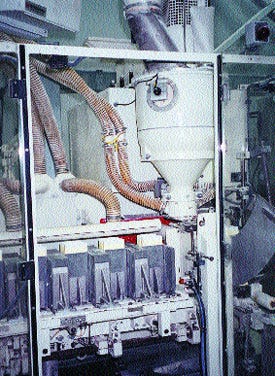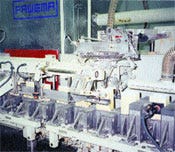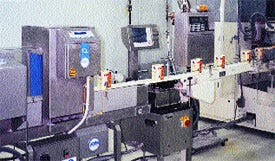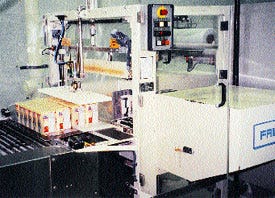Fill/seal system offers a mixed bag
|
Product is dispensed into open-topped bags by a revolving auger filler. The quantity of product is determined by the number of revolutions of the auger, as well as its speed and acceleration. |
Founded a mind-boggling 191 years ago, House-Autry Mills has the motto "The choice of southern cooks since 1812." The House family relocated that year from England to Newton Grove, NC, where their original mill was built. The original millstones were brought from England. Over the years, House's mill continued to expand and in 1967 merged with the Autry Brothers Mill Co. to form what is today known as House-Autry Mills. Cornmeal was the number-one product line for many years, but the company's products eventually expanded to include a line of quality breaders and mixes, such as hush puppy mix, cracker meal, and other items. The company now produces more than 60 different products in 8-oz and 2- and 5-lb retail package sizes, and in 25- and 50-lb foodservice sizes.
In January, '01, House-Autry Mills relocated its entire operation to a new facility in Four Oaks, NC. At that time, the company installed two new packaging lines incorporating bag filling/sealing machines and stretch wrappers from Fawema Packaging Machinery for the 2- and 5-lb bags. It is now in the process of installing a new line, also with Fawema equipment, for the foodservice sizes. "We are very happy with the Fawema equipment. The two- and five-pound machines have run very well since they were installed, and Fawema has given us great service and training," says vp of operations Tim Johns. "We bought the Fawema FA PL/K-D 330 twenty-five- and fifty-pound machine from Fawema because of the great success we had with the retail-size machines, and especially because of the outstanding service and support we received from Fawema's Sarasota, Florida, office." All products are packaged in open-topped paper bags from Bancroft Bag, Inc. The bags for retail products are two-ply, with a bleached-sheet interior and a clay-coated exterior. The 7-color flexo-printed bags have a water-based exterior lacquer coating to prevent ink scuffing.
Retail lines are mirror images
The retail-size lines, which are installed side-by-side, are mirror images of each other, so that both lines can be operated by one crew located between them. The 2- and 5-lb packages are run on Fawema Type FA 10L-PL/K-D machines that run 50 bags/min. The FA-10 machine is an intermittent-motion machine equipped with a chamber system for bag transport. One of the characteristics of this machine is that it produces a very tight "brick-like" bag; the "L" designation indicates that the machine has a lengthened vibration settling track for products that require long and intensive settling to achieve a tight bag shape. The PL/K-D designation refers to a type of bag closure and means that the machine performs a packet closure with a double fold to eliminate any possible sifting after the bag is sealed. The machine operates intermittently, and the various procedures take place while the machine is stopped.
|
The machine has 18 individual chambers into which bags are placed for transportation through the machine. |
Product is delivered from a floor hopper up to the overhead fill hopper on the machine by a screw conveyor. To start the bag-filling operation, an arm with suction cups swings in and removes a flattened block-bottom bag from the magazine. As the arm swings out to place the bag on the transport track, the transport suction nozzle and the stationary suction nozzle are pulling the bag open, after which clamps grip the sides of the bag to keep it open during the filling process. An additional bag-bottom opener ensures that the bag is totally open before the product is filled.

The machine has 18 chambers that move together and are controlled by a long stroke and cross-stroke cam-driven system to ensure that the bag is enclosed from all four sides at any given time in the filling/closing machine. This controls bulging and settling of the product, resulting in a very tight, "brick-like" bag.
The machine takes 18 stop/start cycles from the time the bag is filled until it discharges. If we count the filling operation as taking place at station one, each subsequent operation can be tracked by counting the cycles after filling and assigning it a station number.
After being placed in the transport chamber system, the open-topped bag is transported beneath the product hopper, and a revolving auger dispenses the product. The quantity of product is determined by the number of revolutions of the auger, as well as its speed, and by the acceleration and deceleration time of the auger. The product is settled by vibration, which starts in the filling section. Depending on the product characteristics, the vibration is changed by adjusting its amplitude and frequency.
When the bag reaches the fourth station, a vertical arm with a flat end descends and tamps the product to assist in compacting it inside the bag to ensure a flat product surface for the subsequent prefolding process. Vibrating continues until the ninth station, where the sides of the bag are prefolded by a combination of four fingers that descend into the bag and two fingers that are outside the bag. After the fingers are in place, they move to prefold and precrease the top, and form the shoulder of the bag. Suction at the top of the bag at this station removes any dust that is present.
A height sensor at station 12 makes sure that the product level has the correct height, while another sensor at station 13 checks to make sure that the bag is oriented properly for trimming. A scissors-action cutter trims excess bag material, and fingers again crease the top of the bag at station 14. Additional folding steps take place at stations 15 and 16, while the final fold takes place at station 17. To produce the packet closure with a double fold, the final fold is a three-step process. The first folding fork comes in from the front to hold the bag-top in place, and the second folding fork comes in from the back to make the first and second fold toward the front. The third folding fork (or compression plate) then presses the fold for the first time and guides the bag-top into the next station, where it is pressed again to guarantee a stable closure.
Hot-melt adhesive is applied to the bag by a Nordson system as the bag is transported from station 17 to 18, after which a flat plate descends and presses the top down flat at station 18.
As the bags discharge from the machine, they are inspected for open tops, and then they pass over a Mettler-Toledo checkweigher incorporating a statistical tracking procedure that sends a signal to the filler to adjust the number of revolutions of the fill auger to maintain the proper bag weight. Underweight bags or those with open tops are rejected into a bin as they leave the checkweigher. After the bags pass through a Loma International metal detector, a Videojet ink-jet printer applies a production code to the top of the bag. It is conveyed to the Fawema shrink bundler, which assembles 2-lb bags into 2 x 6 12-pack bundles, or 5-lb bags into 2 x 3 six-pack bundles. The bundler uses a roll of film on the top and one on the bottom of the bundle, and the edges are sealed after the bags are in place. The bundles then pass through a heating tunnel that shrinks the film tightly around them.
|
Bags leaving the fill/seal machine pass an ink-jet printer, checkweigher and metal detector. The checkweigher sends a signal to the filler to adjust the number of revolutions of the fill auger to maintain the proper bag weight. |
The FAWEMA FA-10 machine is designed to handle multiple types of dry, granulized or powdered solids, and it is also configurable for different size bags and various rates of throughput. To handle these various applications, the machine is equipped with servo drives from Emerson and incorporates the Emerson Control Techniques software and operator interface panel, which allows the user to change the machine quickly and easily. This technology maximizes the customer's value by combining high output with exceptionally accurate filling that minimizes overfilling.
"The Fawema equipment produces a much nicer package than we had previously," says president, COO and CFO Roger Mortenson. "We can use slicker paper, and the filling and vibrating system produces a solid, brick-like package."
More information is available:
Fill/seal machine, shrink bundler: Fawema Packaging Machinery, 941/351-9597. Circle No. 201.
Bags: Bancroft Bag, Inc., 843/886-9666. Circle No. 202.
Hot-melt system: Nordson Corp., 770/497-3715. Circle No. 203.
Checkweigher: Mettler-Toledo, Inc., 614/438-4511. Circle No. 204.
Metal detector: Loma International, Inc., 630/681-2050. Circle No. 205.
Ink-jet printer: Videojet Technologies, 630/860-7300. Circle No. 206.
Servo drives, controls: Emerson Motion Control, 952/995-8000. Circle No. 207.
|
Shrink bundler assembles 2-lb bags into 2 x 6 12-pack bundles, or 5-lb bags into 2 x 3 six-pack bundles. |
About the Author(s)
You May Also Like






